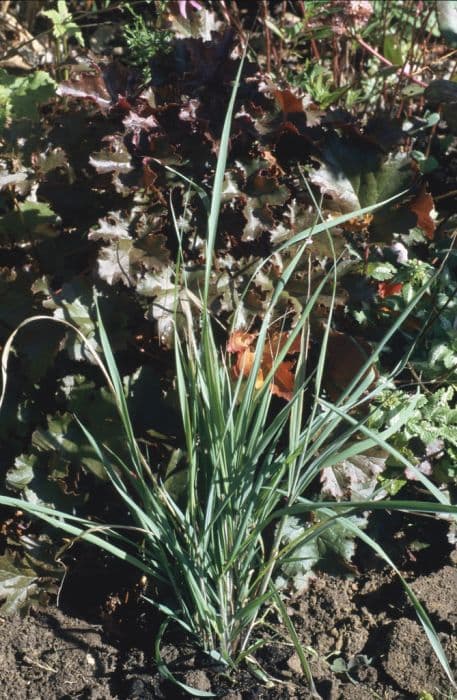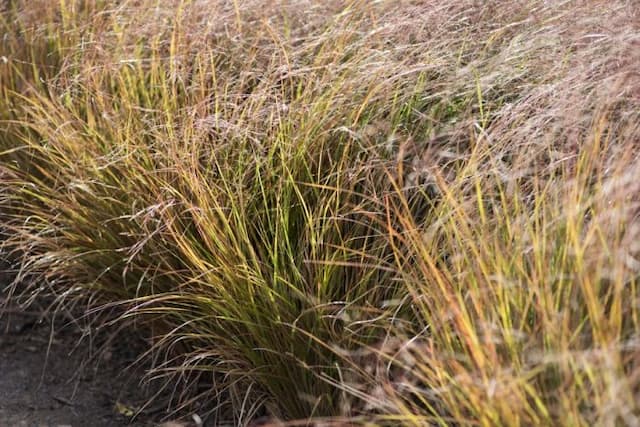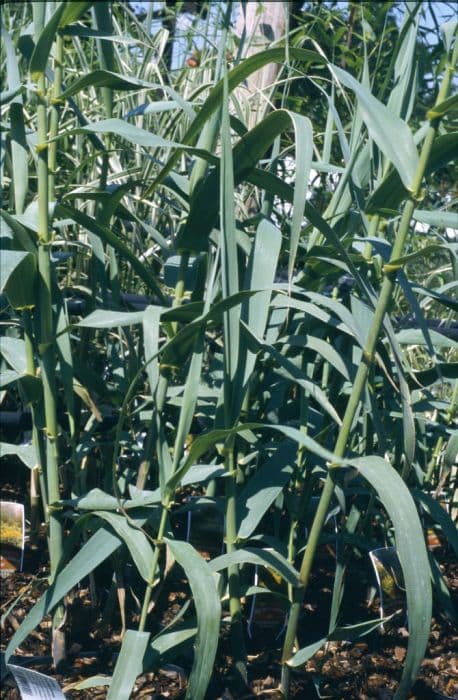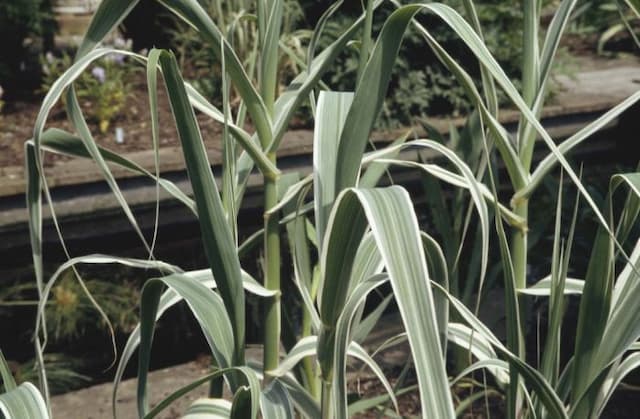Indian Grass Sorghastrum nutans

ABOUT
Known commonly as Indian grass, this perennial plant is recognized by its slender, upright form and its tendency to grow in dense tufts. Its foliage is typically blue-green to green in color, which turns into a striking copper, golden, or orange hue come fall. This transformation adds a warm, seasonal tone to the landscape. The leaves are long and narrow, with a prominent vein running down the center and rough edges that feel serrated to the touch. The defining feature of the Indian grass is its fluffy, feathery flower spikes that appear on top of tall, slender stalks. These blooms range from yellow to golden brown and add texture and movement to the plant's profile as they catch the breeze. The flowers typically appear in late summer and persist into the autumn, giving the landscape a distinctive, rustic look. Following its flowering phase, Indian grass produces seeds that are held in small, hard capsules which contribute to its natural reseeding. This native grass is often appreciated for its ruggedness and its ability to thrive in a wide range of soil conditions. It is a staple in naturalized areas, prairie restorations, and wildflower meadows where its visual appeal and adaptability are highly valued. Its deep, fibrous root system makes it a great solution for soil erosion control. Moreover, Indian grass is known to attract wildlife, offering shelter and food sources for birds and insects, thus enhancing the ecological value of the areas where it is grown.
About this plant
 Names
NamesFamily
Poaceae.
Synonyms
Yellow Indian Grass, Indiangrass, Yellow Indiangrass.
Common names
Andropogon nutans, Chrysopogon nutans, Sorghastrum avenaceum, Sorghum nutans, Holcus nutans.
 Toxicity
ToxicityTo humans
Indian grass, which is commonly known as Sorghastrum nutans, is not considered toxic to humans. There is no widely recognized toxicity associated with this plant, and it is typically safe to handle and, in non-toxic quantities, could be ingested without adverse effects. However, it's important to note that plants not typically classified as toxic can sometimes cause mild irritation or allergic reactions in sensitive individuals. If someone has ingested Indian grass and is experiencing unusual symptoms, they should seek medical attention.
To pets
Indian grass, the common name for Sorghastrum nutans, is not known to be toxic to pets. This grass is not associated with poisoning in domestic animals such as dogs and cats, and it is generally considered safe for them to be around this plant. Of course, ingestion of large amounts of any non-food plant material can potentially lead to gastrointestinal upset, such as vomiting or diarrhea, due to the irritation of the stomach or intestines, but this is a non-specific response rather than a toxicity reaction. If a pet exhibits adverse symptoms after consuming Indian grass, it is advisable to consult a veterinarian.
 Characteristics
CharacteristicsLife cycle
Perennials
Foliage type
Deciduous
Color of leaves
Green
Flower color
Yellow
Height
3-5 feet (0.9-1.5 meters)
Spread
2-3 feet (0.6-0.9 meters)
Plant type
Herb
Hardiness zones
4
Native area
North America
Benefits
 General Benefits
General Benefits- Erosion Control: Sorghastrum nutans has a deep root system that helps stabilize soil and prevent erosion.
- Wildlife Habitat: It provides shelter and food for wildlife, including birds that feed on its seeds and insects that use the plant for habitat.
- Drought Resistance: It is highly drought-resistant once established, making it suitable for xeriscaping and low-water landscapes.
- Pasture Improvement: It can be used to improve pasture quality and provide forage for grazing livestock.
- Biodiversity: It contributes to ecological diversity as a native prairie grass and supports a range of prairie-dependent species.
- Aesthetic Appeal: With its tall stature and attractive flowering plumes, it is often used in naturalistic landscaping and ornamental gardening.
- Soil Health: Its roots promote soil health by increasing soil organic matter and aiding in nutrient cycling.
- Low Maintenance: Once established, it requires little maintenance, with no need for fertilizers or pesticides.
- Windbreak: It can be planted in rows to act as windbreaks, reducing soil erosion and protecting crops or areas from damaging winds.
- Support for Beneficial Insects: The plant can support pollinators and other beneficial insects, contributing to a healthy ecosystem.
- Cultural Significance: It has historical and cultural importance to many indigenous peoples of the prairies, who used various parts of the plant for traditional purposes.
 Medical Properties
Medical PropertiesThis plant is not used for medical purposes.
 Air-purifying Qualities
Air-purifying QualitiesThis plant is not specifically known for air purifying qualities.
 Other Uses
Other Uses- Indian grass, as Sorghastrum nutans is commonly known, can be used for making musical instruments such as flutes and panpipes due to its long, hollow stems.
- The plant’s sturdy stems can be employed in the construction of lightweight frameworks for kites or model airplanes.
- Native Americans once used Indian grass as a ceremonial plant, incorporating it into various rituals and spiritual practices.
- The seed heads of Indian grass can be incorporated into floral arrangements and decorative displays for their unique texture and color.
- Fibers from Indian grass can be twisted into cords or ropes for craft projects or even small-scale practical uses, like garden ties.
- The dried stems can serve as a natural kindling material for starting fires due to their quick ignition properties.
- Indian grass can be planted for erosion control, as its robust root system helps hold soil in place on slopes and disturbed areas.
- Dried Indian grass can be used as a stuffing material for small handcrafted dolls or toys, providing a sustainable alternative to synthetic fillers.
- The plant's tall and striking appearance makes it a popular choice for theatrical set designs, simulating natural grasslands or prairies.
- Indian grass can be used in the production of eco-friendly packing materials, such as biodegradable stuffing or padding.
Interesting Facts
 Feng Shui
Feng ShuiThe Indian Grass is not used in Feng Shui practice.
 Zodiac Sign Compitability
Zodiac Sign CompitabilityThe Indian Grass is not used in astrology practice.
 Plant Symbolism
Plant Symbolism- Resilience: Also known as Indian grass, Sorghastrum nutans is native to North America and thrives in prairies, which can face harsh conditions. Thus, it symbolizes the ability to endure and recover from adversity.
- Sustainability: Indian grass is a vital component of the prairie ecosystem and its deep root system helps to prevent soil erosion. This reflects a message of sustainable living and environmental preservation.
- Adaptability: Indian grass can adapt to a wide range of soil types and conditions, representing flexibility and the ability to thrive in various circumstances.
- Heritage and Tradition: Given its place as a dominant prairie grass, Indian grass symbolizes the natural heritage of the plains and the cultural traditions of the Native American tribes who once depended on the prairie ecosystem.
- Growth and Fertility: As a tall grass that contributes to the rich biodiversity of the prairies, Indian grass symbolizes growth and fertility, echoing the abundance of life sustained by grasslands.
 Water
WaterIndian Grass should be watered deeply and infrequently to encourage a strong root system. Ideally, it should receive about 1 inch of water each week, either from rainfall or supplemental watering. During hot, dry periods, you may need to water every 7-10 days, adjusting the schedule according to soil moisture levels. Over-watering can lead to root rot, so ensure the soil dries out between watering sessions. It's best to water early in the morning to reduce evaporation and allow foliage to dry out, reducing the risk of fungal diseases.
 Light
LightIndian Grass thrives best in full sunlight conditions, receiving at least 6 hours of direct sunlight daily. It can tolerate some partial shade but will perform best in an open area where it's exposed to unfiltered, direct light throughout most of the day. Avoid placing Indian Grass in deep shade, as this can lead to poor growth and reduced foliage density.
 Temperature
TemperatureIndian Grass is hardy and adapts well to a range of temperature conditions, able to withstand winter temperatures down to around -20°F. The ideal growing temperature range for Indian Grass is between 75°F and 90°F during its active growth period in the summer months. It's a resilient species that can survive high summer temperatures and recovers well from brief cold snaps.
 Pruning
PruningPruning Indian Grass is primarily done to maintain its shape and remove old foliage. It's best to cut back the grass clumps to about 6 inches above the ground in late winter or early spring before new growth begins. This yearly pruning allows for a neat, tidy appearance and promotes vigorous new growth in the coming season. Pruning too early or too frequently can harm the plant's natural growth cycle.
 Cleaning
CleaningAs needed
 Soil
SoilIndian Grass thrives in well-draining soil with a mix of loam, sand, and compost; maintain a soil pH of 5.5 to 7.0 for optimal growth.
 Repotting
RepottingIndian Grass, being a perennial, does not typically require repotting as it is usually grown outdoors and can spread naturally.
 Humidity & Misting
Humidity & MistingIndian Grass is tolerant of a wide range of humidity conditions and does not have specific humidity requirements.
 Suitable locations
Suitable locationsIndoor
Grow Indian Grass indoors with ample light and space.
Outdoor
Plant Indian Grass in full sun, well-drained soil.
Hardiness zone
4-9 USDA
 Life cycle
Life cycleSorghastrum nutans, commonly known as Indiangrass, begins its life cycle as a seed which germinates in the spring when soil temperatures are suitable. Upon germination, the young shoot (coleoptile) emerges from the soil and develops into a seedling with a network of roots and foliage. As the plant matures, it establishes a strong root system and a clumping growth form, with leaves expanding and forming the distinctive blue-green to green foliage. Through the summer, Indiangrass enters a vegetative stage where it focuses on photosynthesis and growth, eventually producing tall, upright flowering stems called culms. In late summer to early fall, the plant reaches the reproductive stage, displaying feathery, golden-brown flower panicles which produce seeds. After setting seed, the plant enters senescence in late fall or early winter, potentially remaining dormant until the next spring or dying, depending on the conditions, thus completing its life cycle.
 Propogation
PropogationPropogation time
Spring-Early Summer
Sorghastrum nutans, commonly known as Indian grass, is typically propagated through seed sowing. The best time to propagate this native prairie grass is in the spring or late fall. The commonly used method involves collecting ripe seeds from the plant in the late summer or early fall. These seeds are then surface sown onto a prepared seedbed. The seeds require light to germinate, so pressing them lightly into the soil without covering with additional soil is important for successful germination. The soil should be kept lightly moist until germination occurs. For larger areas or commercial production, the seeds may be mixed with a carrier such as sand to ensure even distribution when sowing. It's important not to sow the seeds too deeply, as this will inhibit germination, keeping them at a depth no more than 1/4 inch (about 6 millimeters) below the soil surface.









